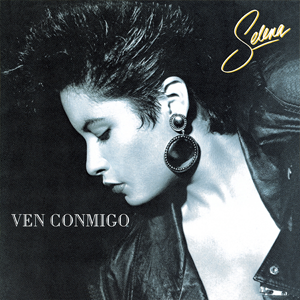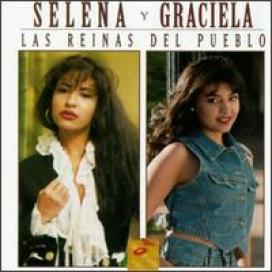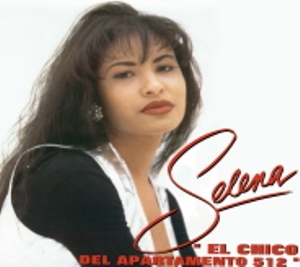
Selena Quintanilla Pérez was an American singer. Referred to as the "Queen of Tejano Music", her contributions to music and fashion made her one of the most celebrated Mexican-American entertainers of the late 20th century. In 2020, Billboard magazine put her in third place on their list of "Greatest Latino Artists of All Time", based on both Latin albums and Latin songs chart. Media outlets called her the "Tejano Madonna" for her clothing choices. She also ranks among the most influential Latin artists of all time and is credited for catapulting the Tejano genre into the mainstream market.

Ven Conmigo is the second studio album by American singer Selena, released on November 12, 1990, by EMI Latin. The singer's brother, A.B. Quintanilla III remained her principal record producer and songwriter after her debut album's moderate success. Selena's Los Dinos band composed and arranged seven of the album's ten tracks; local songwriter Johnny Herrera also provided songs for Selena to record. Ven Conmigo contains half cumbias and half rancheras, though the album includes other genres. Its musical compositions are varied and demonstrate an evolving maturity in Selena's basic Tejano sound. The album's structure and track organization were unconventional compared with other Tejano music albums. The songs on Ven Conmigo are mostly love songs or songs following a woman's struggles after many failed relationships.

Selena is the debut studio album by American Tejano singer Selena, released on October 17, 1989, by EMI Latin. Its music incorporates a range of contemporary genres with a mix of cumbia and regional styles of Mexican music. The album was released following company president Jose Behar's failed crossover request for the singer. The project was denied by the heads of EMI Records' pop division, believing the singer should first strengthen her fanbase. Selena's brother and principal record producer and songwriter, A.B. Quintanilla III fought to remain the singer's producer. The band introduced Pete Astudillo and Joe Ojeda, who contributed to the album's experimental production and songwriting. Aside from A.B., Selena worked with two Mexican songwriters, Alejandro Montealegre and Reinaldo Ornelas.

Live! or Selena Live! is a live album by American Tejano pop singer Selena, which was released on May 4, 1993, by EMI Latin. The album was re-released on September 22, 2002, as being part of the Selena: 20 Years of Music collection; which included spoken liner notes by her family, friends and her former band members Selena y Los Dinos. Live! includes three cumbia-influenced studio tracks, while the rest of the album consists of live versions of previously released songs. The album was recorded during a free concert at the Memorial Coliseum in Corpus Christi, Texas, on February 7, 1993. It was certified gold by the Recording Industry Association of America in its first year, double platinum in 1995, and 8× platinum in 2017.

Mis Mejores Canciones – 17 Super Éxitos is a greatest hits album by American singer Selena released on September 17, 1993, through EMI Latin. Beginning in January 1993, the label released a comprehensive collection that spotlighted its Latin music artists as part of its Latin Classics series. Mis Mejores Canciones – 17 Super Exitos encompasses 17 tracks, ranging from songs recorded on her debut album with EMI Latin, to songs present in Entre a Mi Mundo (1992). The album received a positive response from music critics who enjoyed the label's catalog releases and praised the tracks on the album for showcasing Selena's early popular recordings. Following the shooting death of Selena on March 31, 1995, Mis Mejores Canciones – 17 Super Exitos debuted at number one on the US Billboard Top Catalog Albums chart, the first Spanish-language recording to do so. The Recording Industry Association of America (RIAA) certified the album diamond (Latin), denoting 600,000 units shipped in the United States.
Selena ¡Vive! was a benefit concert which was held on the tenth anniversary of the death of Tejano superstar Selena Quintanilla-Pérez. The concert was held on April 7, 2005 at the Reliant Stadium in Houston, Texas with over 70,000 attendees. The special was produced and filmed by the Spanish language network, Univision, and was the most-watched special in the Spanish language in the history of American television. Event host Univision announced that proceeds from "¡Selena Vive!" will go toward 10 scholarships for students looking to pursue higher education at Texas universities.

Pedro Astudillo, known as Pete Astudillo, is an American singer-songwriter, record producer, and dancer. Referred to as "the Latino Babyface" by The Daily Journal, he is regarded as the architect behind Selena's sound, as he collaborated or coauthored the singer's top-selling and most popular recordings that cemented him into music history. Astudillo wrote or collaborated on some of the most popular Tejano music songs of the 1990s and was inducted into the Tejano Roots Hall of Fame in 2019. His impact on the United States Latin music scene lies in his role as a songwriter collaborator, according to Billboard magazine.

"Techno Cumbia" is a song recorded by American singer Selena for her fourth studio album, Amor Prohibido (1994). It was posthumously released as the b-side track to "Dreaming of You" through EMI Latin on August 14, 1995. Techno Cumbia would be put on her fifth and final studio album Dreaming of You (1995) and would be the fourth single for Dreaming Of You. "Techno Cumbia" was written by Pete Astudillo and co-written and produced by Selena's brother-producer A.B. Quintanilla. The song is a dance-pop and tecnocumbia recording with influences of dancehall, rap, Latin dance, and club music. Lyrically, Selena calls on people to dance her new style the "techno cumbia" and calls out those who cannot dance.

Las Reinas del Pueblo is a compilation album by American Tejano music singer Selena and Mexican banda singer Graciela Beltrán. It was released on April 4, 1995, by EMI Latin in the wake of Selena's death on March 31, 1995. The decision to produce a compilation album featuring Beltrán emerged after her tribute to the singer at a Houston memorial. The title was inspired by Mexican newspapers that referred to Selena as "an artist of the people" during a 1992 press tour in the nation and subsequently dubbed her "La Reina del Pueblo" in the aftermath of her death. Las Reinas del Pueblo encompasses six tracks by Selena and six by Beltrán, encapsulating their respective tenures with EMI Latin. Las Reinas del Pueblo peaked at number four on the US Billboard Top Latin Albums and Regional Mexican Albums chart, both behind other Selena releases. The recording peaked at number 147 on the American Billboard 200 chart. The album peaked at number ten on the Spanish albums chart in 2010. Beltrán's participation in the album yielded substantial promotional and sales enhancements.

"No Debes Jugar" is a song recorded by American recording artist Selena and released as the lead single from her first live album Live! (1993). It was composed by Selena y Los Dinos keyboardist Ricky Vela and Selena's brother and principal record producer A.B. Quintanilla III and produced by Quintanilla III and Argentine music producer Bebu Silvetti. It is an uptempo Mexican cumbia song with influences of Rock en Español which is centered on female empowerment. Lyrically, the song describes a woman who threatens to leave her unappreciative boyfriend.

"Ámame" is a song by American singer Selena, taken from her third studio album, Entre a Mi Mundo (1992). Selena and Chris Pérez began secretly dating subsequent to Pérez's reintegration into Selena y Los Dinos in the summer of 1991, despite her father's objections. The song was written by Selena and conveys her sentiments towards Pérez as they concealed their liaison from familial scrutiny. Pete Astudillo contributed to the lyrical development of the composition, while A. B. Quintanilla handled production. It was released as the fourth and final single from the album in April 1993.

"Como la Flor" is a song recorded by American singer Selena. Written by A. B. Quintanilla and Pete Astudillo, it was released as the second single from her third studio album Entre a Mi Mundo (1992). The song was written by Quintanilla, who was inspired by a family selling illuminated plastic flowers at a concert in Sacramento, California, in 1982. A decade later, Quintanilla was seized with an infectious melody and abruptly dashed out of the shower in a hotel room in Bryan, Texas, to recreate it on a keyboard with Astudillo. He completed the music in just 20 minutes, while Astudillo took another hour to complete the lyrics. "Como la Flor" is an up-tempo, Tejano cumbia torch song that blends tropical cumbia rhythms with hints of reggae and pop music. Its lyrics describe the feelings of a female protagonist addressing her former lover, who abandoned her for another partner. The narrator is uncertain of her ability to love again, while at the same time, wishing her former partner and his new lover the best.

"La Carcacha" is a song recorded by American singer Selena for her third studio album, Entre a Mi Mundo (1992). The song was written by A.B. Quintanilla and Pete Astudillo. It was inspired by a dilapidated car and an experience in which A.B. observed a woman's willingness to court the owner of a luxury car. The song, characterized by its rhythmic melodies and satirical portrayal of life in the barrio, highlights the importance of love and genuine connection over material wealth. It is a Tejano cumbia song that is emblematic of Selena's typical style, while music critics found it to be musically similar to "Baila Esta Cumbia".

"Si Una Vez" is a song recorded by American recording artist Selena for her fourth studio album, Amor Prohibido (1994). It was written by Pete Astudillo and produced by Selena's brother-producer A.B. Quintanilla. "Si Una Vez" is a mariachi fusion song and draws influence from cumbia and Latin dance music. Lyrically, Selena questions why she ever fell in love with an abusive partner, saying she will never repeat her mistakes. The lyrics suggest unrequited love and female empowerment.

"El Chico del Apartamento 512" is a song recorded by American recording artist Selena for her fourth studio album, Amor Prohibido (1994). It was released along with "Fotos y Recuerdos" in January 1995, serving as its B-side track. Written by Ricky Vela, "El Chico del Apartamento 512" is a cumbia song with influences of Colombian and South American music. Lyrically, the song describes a female protagonist who knocks on her love interest's apartment door and is heartbroken when his sister answers it. Justino Aguilar of Billboard magazine, called "El Chico del Apartamento 512" as one of Selena's "most memorable songs". The track posthumously peaked at number one on the U.S. Billboard Regional Mexican Digital Songs chart in 2011.

"No Quiero Saber" is a song recorded by American recording artist Selena. It was originally a track on her second studio album Ven Conmigo (1990). It was composed and produced by her brother, A.B. Quintanilla III. Pete Astudillo, a backup singer with Selena y Los Dinos, produced the song with Quintanilla. The recording was later remixed by Quintanilla III for Selena's 1996 first remix album, Siempre Selena. It was released posthumously by EMI Latin in June 1996, as the album's second single, behind "Siempre Hace Frio".

"Baila Esta Cumbia" is a song recorded by American Tejano singer Selena for her second studio album, Ven Conmigo (1990). It was released as the second single by EMI Latin on August 28, 1990, behind "Ya Ves". It was composed by her brother–producer A.B. Quintanilla, and Selena y Los Dinos backup dancer, Pete Astudillo. The recording is an up-tempo Mexican cumbia song. It was well received by music critics who enjoyed its cumbia-feel and rhythm.

"Donde Quiera Que Estés" is a duet recorded by American Latin pop quintet the Barrio Boyzz and American Tejano singer Selena. Released on the Barrio Boyzz' album of the same name, "Donde Quiera Que Estés" was written by K. C. Porter, Miguel Flores, Desmond Child, and produced by A.B. Quintanilla III, Domingo Padilla and Bebu Silvetti. The lyrics explore feelings felt after a breakup between first-time lovers who hope that their love will one day return. "Donde Quiera Que Estés" is a dance pop song with influences from hip-hop music.

Abraham Isaac Quintanilla III, known professionally as A.B. Quintanilla III or A.B. Quintanilla, is an American record producer, songwriter and musician. Called the "King of Kumbia" due to his influence and impact on the cumbia music genre, he is the older brother of singer Selena, known as the "Queen of Tejano Music", having produced and written many of her hit songs throughout her career, is the creator and founder of the bands Kumbia Kings and Kumbia All Starz, also having produced and written their hit songs as well as performing as a member of both, and has contributed, produced and written many songs for other artists.

Dulce Amor is the sixth and last independent studio album by Tejano music group Selena y Los Dinos. The album became the final album to be released from RP Records on December 24, 1988. Selena's brother, A.B. Quintanilla III had become the main songwriter. Selena recorded fourteen songs but only released ten. All the songs were recorded in three different recording studios. Dulce Amor helped Selena to be noticed at the 1989 Tejano Music Awards. She was then signed by EMI Latin. This would be the last studio album to be released under “Selena y Los Dinos” as all subsequent albums would be released under “Selena”. The album had only sold over 30,000 copies. It was ordered to be removed from stores by EMI Records.



















